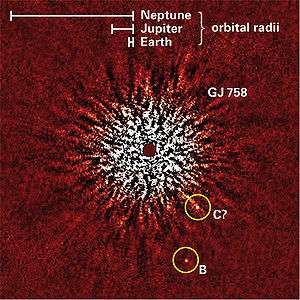Gliese 758
 Discovery image of Gliese 758 b, taken with Subaru HiCIAO in the near infrared. | |
| Observation data Epoch J2000.0 Equinox J2000.0 | |
|---|---|
| Constellation | Lyra |
| Right ascension | 19h 23m 34.01358s[1] |
| Declination | +33° 13′ 19.0725″[1] |
| Apparent magnitude (V) | 6.36[2] |
| Characteristics | |
| Spectral type | G8V[3] |
| U−B color index | +0.455[2] |
| B−V color index | +0.799[2] |
| Astrometry | |
| Radial velocity (Rv) | -22.0[4] km/s |
| Proper motion (μ) | RA: 83.40[1] mas/yr Dec.: 162.32[1] mas/yr |
| Parallax (π) | 63.45 ± 0.35[1] mas |
| Distance | 51.4 ± 0.3 ly (15.76 ± 0.09 pc) |
| Absolute magnitude (MV) | 5.37[5] |
| Details | |
| Mass | 0.966[6] M☉ |
| Radius | 0.88[6] R☉ |
| Surface gravity (log g) | 4.55[6] cgs |
| Temperature | 5,425[3] K |
| Metallicity [Fe/H] | 0.18[3] dex |
| Age | 7.7–8.7[7] Gyr |
| Other designations | |
| Database references | |
| SIMBAD | data |
| Extrasolar Planets Encyclopaedia | data |
Gliese 758 is a star in the northern constellation of Lyra.[1] At about magnitude 6 it is a challenge to view with the naked eye even in good seeing conditions, but can be easily seen through a small telescope or binoculars. Parallax measurements from the Hipparcos mission give it an estimated distance of around 51.4 light-years (15.8 parsecs) from Earth.
This is a Sun-like star with 97% of the Sun's mass and 88% of the radius of the Sun. The spectrum matches a stellar classification of G8V,[3] identifying it as a G-type main sequence star that is generating energy through the nuclear fusion of hydrogen at its core. It is radiating this energy into space from its outer envelope at an effective temperature of 5425 K.[3] Estimates of its age put it at about 7.7–8.7 billion years old,[7] although some measurements give it an age as low as 720 million years.[6] The abundance of elements other than hydrogen and helium, what astronomers term the star's metallicity, are 51% higher than in the Sun.[3]
System
In November 2009, a team using the HiCIAO instrument of the Subaru Telescope imaged a substellar companion orbiting the star. This object, designated Gliese 758 b, was estimated to be of approximately 10-40 Jupiter masses. A second candidate object was also detected, which was given the designation Gliese 758 C.[9][10] Follow-up studies of the system suggested the mass range of Gliese 758 b, indicating it to be a companion with approximately 30 to 40 Jupiter masses and revealed that Gliese 758 C is a background star which is not physically associated with the Gliese 758 system.[11] On the other hand, a younger age was suggested from the kinematic stellar grouping.
See also
References
- 1 2 3 4 5 6 van Leeuwen, F. (November 2007). "Validation of the new Hipparcos reduction". Astronomy and Astrophysics 474 (2): 653–664. arXiv:0708.1752. Bibcode:2007A&A...474..653V. doi:10.1051/0004-6361:20078357.
- 1 2 3 Breger, M. (March 1968), "UBV and narrow-band UVBY photometry of bright stars", Astronomical Journal 73: 84–85, Bibcode:1968AJ.....73...84B, doi:10.1086/110602
- 1 2 3 4 5 6 Soubiran, C.; et al. (2008). "Vertical distribution of Galactic disk stars. IV. AMR and AVR from clump giants". Astronomy and Astrophysics 480 (1): 91–101. arXiv:0712.1370. Bibcode:2008A&A...480...91S. doi:10.1051/0004-6361:20078788.
- ↑ Nordström, B.; et al. (May 2004), "The Geneva-Copenhagen survey of the Solar neighbourhood. Ages, metallicities, and kinematic properties of ˜14 000 F and G dwarfs", Astronomy and Astrophysics 418: 989–1019, arXiv:astro-ph/0405198, Bibcode:2004A&A...418..989N, doi:10.1051/0004-6361:20035959
- ↑ Holmberg, J.; Nordström, B.; Andersen, J. (July 2009), "The Geneva-Copenhagen survey of the solar neighbourhood. III. Improved distances, ages, and kinematics", Astronomy and Astrophysics 501 (3): 941–947, arXiv:0811.3982, Bibcode:2009A&A...501..941H, doi:10.1051/0004-6361/200811191
- 1 2 3 4 Takeda, Genya; et al. (February 2007), "Structure and Evolution of Nearby Stars with Planets. II. Physical Properties of ~1000 Cool Stars from the SPOCS Catalog", The Astrophysical Journal Supplement Series 168 (2): 297–318, arXiv:astro-ph/0607235, Bibcode:2007ApJS..168..297T, doi:10.1086/509763
- 1 2 Mamajek, Eric E.; Hillenbrand, Lynne A. (November 2008), "Improved Age Estimation for Solar-Type Dwarfs Using Activity-Rotation Diagnostics", The Astrophysical Journal 687 (2): 1264–1293, arXiv:0807.1686, Bibcode:2008ApJ...687.1264M, doi:10.1086/591785
- ↑ NLTT 47754 -- High proper-motion Star, Centre de Données astronomiques de Strasbourg, retrieved 2009-12-13
- ↑ Thalmann, C.; et al. (2009), "Discovery of the Coldest Imaged Companion of a Sun-Like Star", The Astrophysical Journal Letters 707 (2): L123–L127, arXiv:0911.1127, Bibcode:2009ApJ...707L.123T, doi:10.1088/0004-637X/707/2/L123
- ↑ "Discovery of an Exoplanet Candidate Orbiting a Sun-Like Star: Inaugural Observations with Subaru's New Instrument HiCIAO", Subaru Telescope, 2009-12-03, retrieved 2009-12-04
- ↑ Janson, M.; Carson, J.; Thalmann, C.; McElwain, M. W.; Goto, M.; Crepp, J.; Wisniewski, J.; Abe, L.; Brandner, W.; Burrows, A.; Egner, S.; Feldt, M.; Grady, C. A.; Golota, T.; Guyon, O.; Hashimoto, J.; Hayano, Y.; Hayashi, M.; Hayashi, S.; Henning, T.; Hodapp, K. W.; Ishii, M.; Iye, M.; Kandori, R.; Knapp, G. R.; Kudo, T.; Kusakabe, N.; Kuzuhara, M.; Matsuo, T.; Mayama, S.; Miyama, S.; Morino, J.-I.; Moro-Martín, A.; Nishimura, T.; Pyo, T.-S.; Serabyn, E.; Suto, H.; Suzuki, R.; Takami, M.; Takato, N.; Terada, H.; Tofflemire, B.; Tomono, D.; Turner, E. L.; Watanabe, M.; Yamada, T.; Takami, H.; Usuda, T.; Tamura, M. (2011), "Near-infrared Multi-band Photometry of the Substellar Companion GJ 758 B", The Astrophysical Journal 728 (2), arXiv:1011.5505, Bibcode:2011ApJ...728...85J, doi:10.1088/0004-637X/728/2/85
External links
![]() Media related to Gliese 758 at Wikimedia Commons
Media related to Gliese 758 at Wikimedia Commons
Coordinates: ![]() 19h 23m 34.0s, +33° 13′ 19.1″
19h 23m 34.0s, +33° 13′ 19.1″
| ||||||||||
| ||||||||||||||||||||||||||||||||||||||||||||||||||||||||||||
| ||||||||||||||||||||||||||||||||||||||